Go to the source code of this file.
|
| lcm1602_context | lcm1602_i2c_init (int bus, int address, bool is_expander, uint8_t num_columns, uint8_t num_rows) |
| |
| lcm1602_context | lcm1602_gpio_init (int rs, int enable, int d0, int d1, int d2, int d3, uint8_t num_columns, uint8_t num_rows) |
| |
| void | lcm1602_close (lcm1602_context dev) |
| |
| upm_result_t | lcm1602_write (const lcm1602_context dev, char *buffer, int len) |
| |
| upm_result_t | lcm1602_set_cursor (const lcm1602_context dev, unsigned int row, unsigned int column) |
| |
| upm_result_t | lcm1602_clear (const lcm1602_context dev) |
| |
| upm_result_t | lcm1602_home (const lcm1602_context dev) |
| |
| upm_result_t | lcm1602_create_char (const lcm1602_context dev, unsigned int slot, char *data) |
| |
| upm_result_t | lcm1602_display_on (const lcm1602_context dev, bool on) |
| |
| upm_result_t | lcm1602_cursor_on (const lcm1602_context dev, bool on) |
| |
| upm_result_t | lcm1602_cursor_blink_on (const lcm1602_context dev, bool on) |
| |
| upm_result_t | lcm1602_backlight_on (const lcm1602_context dev, bool on) |
| |
| upm_result_t | lcm1602_scroll_display_left (const lcm1602_context dev) |
| |
| upm_result_t | lcm1602_scroll_display_right (const lcm1602_context dev) |
| |
| upm_result_t | lcm1602_entry_left_to_right (const lcm1602_context dev, bool on) |
| |
| upm_result_t | lcm1602_autoscroll_on (const lcm1602_context dev, bool on) |
| |
| upm_result_t | lcm1602_command (const lcm1602_context dev, uint8_t cmd) |
| |
| upm_result_t | lcm1602_data (const lcm1602_context dev, uint8_t data) |
| |
| lcm1602_context lcm1602_i2c_init |
( |
int |
bus, |
|
|
int |
address, |
|
|
bool |
is_expander, |
|
|
uint8_t |
num_columns, |
|
|
uint8_t |
num_rows |
|
) |
| |
LCM1602 I2C initialization. This is used for those devices using an I2C expander, or other I2C interface. If you are using an expander, you must specify true for the is_expander argument. If not, then the caller of this function is responsible for any transfers to the I2C device. Internally, only direct access to an I2C expander is supported.
- Parameters
-
| bus | I2C bus to use. |
| address | I2C address the LCD is configured for. |
| is_expander | True if we are dealing with an I2C expander, false otherwise. |
| num_columns | Number of columns the display has. |
| num_rows | Number of rows the display has. |
- Returns
- Device Ccontext, or NULL on error.
| lcm1602_context lcm1602_gpio_init |
( |
int |
rs, |
|
|
int |
enable, |
|
|
int |
d0, |
|
|
int |
d1, |
|
|
int |
d2, |
|
|
int |
d3, |
|
|
uint8_t |
num_columns, |
|
|
uint8_t |
num_rows |
|
) |
| |
LCM1602 GPIO (parallel) initialization, used for GPIO based HD44780 controllers supporting RS, Enable, and 4 data pins in 4-bit mode.
- Parameters
-
| rs | Register select pin |
| enable | Enable pin |
| d0 | Data 0 pin |
| d1 | Data 1 pin |
| d2 | Data 2 pin |
| d3 | Data 3 pin |
| num_columns | Number of columns the display has. Default 16. |
| num_rows | Number of rows the display has. Default 2. |
- Returns
- Device Ccontext, or NULL on error.
LCM1602 close.
- Parameters
-
| upm_result_t lcm1602_write |
( |
const lcm1602_context |
dev, |
|
|
char * |
buffer, |
|
|
int |
len |
|
) |
| |
Writes a string to the LCD.
- Parameters
-
| dev | The device context. |
| buffer | Character buffer containing characters to write to the display; note: only ASCII characters are supported |
| len | The number of characters to write. |
- Returns
- UPM result.
| upm_result_t lcm1602_set_cursor |
( |
const lcm1602_context |
dev, |
|
|
unsigned int |
row, |
|
|
unsigned int |
column |
|
) |
| |
Sets the cursor to specified coordinates
- Parameters
-
| dev | The device context. |
| row | Row to set the cursor to. |
| column | Column to set the cursor to. |
- Returns
- UPM result.
Clears the display of all characters.
- Parameters
-
- Returns
- UPM result.
Returns to the home coordinates (0,0).
- Parameters
-
- Returns
- UPM result.
| upm_result_t lcm1602_create_char |
( |
const lcm1602_context |
dev, |
|
|
unsigned int |
slot, |
|
|
char * |
data |
|
) |
| |
Create a custom character.
- Parameters
-
| dev | The device context. |
| slot | The character slot to write, only 8 are available. |
| data | The character data (8 bytes) making up the character. |
- Returns
- UPM result.
Turn the display on.
- Parameters
-
| dev | The device context. |
| on | true to turn display on, false otherwise. |
- Returns
- UPM result.
Turn the cursor on.
- Parameters
-
| dev | The device context. |
| on | true to turn cursor on, false otherwise. |
- Returns
- UPM result.
| upm_result_t lcm1602_cursor_blink_on |
( |
const lcm1602_context |
dev, |
|
|
bool |
on |
|
) |
| |
Turn cursor blink on.
- Parameters
-
| dev | The device context. |
| on | true to turn cursor blink on, false otherwise. |
- Returns
- UPM result.
Turn backlight on.
- Parameters
-
| dev | The device context. |
| on | true to turn backlight on, false otherwise. |
- Returns
- UPM result.
Scroll the display left, without changing the character RAM.
- Parameters
-
- Returns
- UPM result.
Scroll the display right, without changing the character RAM.
- Parameters
-
- Returns
- UPM result.
| upm_result_t lcm1602_entry_left_to_right |
( |
const lcm1602_context |
dev, |
|
|
bool |
on |
|
) |
| |
Set the entry mode so that characters are added left to right.
- Parameters
-
| dev | The device context. |
| on | true to add characters left to right, false for right to left. |
- Returns
- UPM result.
Right justify text entered from the cursor.
- Parameters
-
| dev | The device context. |
| on | true right justify text, false to left justify text. |
- Returns
- UPM result.
Send a command byte to the controller. This is a low level command and should not be used unless you know what you are doing.
- Parameters
-
| dev | The device context. |
| cmd | The command byte to send. |
- Returns
- UPM result.
Send a data byte to the controller. This is a low level command and should not be used unless you know what you are doing.
- Parameters
-
| dev | The device context. |
| data | The data byte to send. |
- Returns
- UPM result.

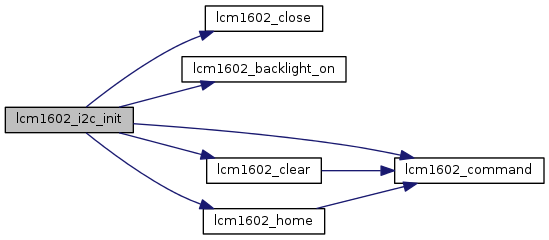
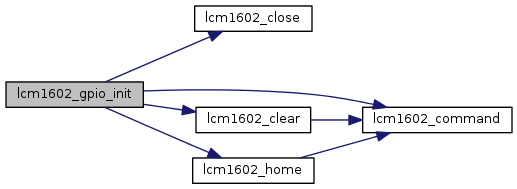







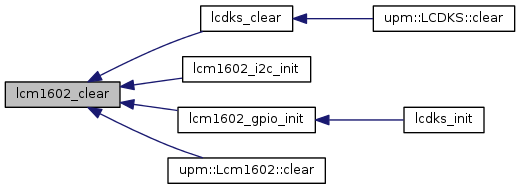

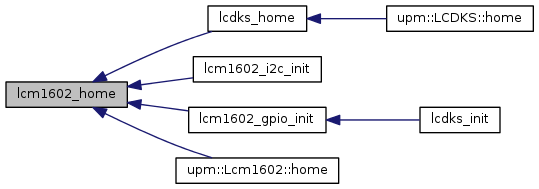

















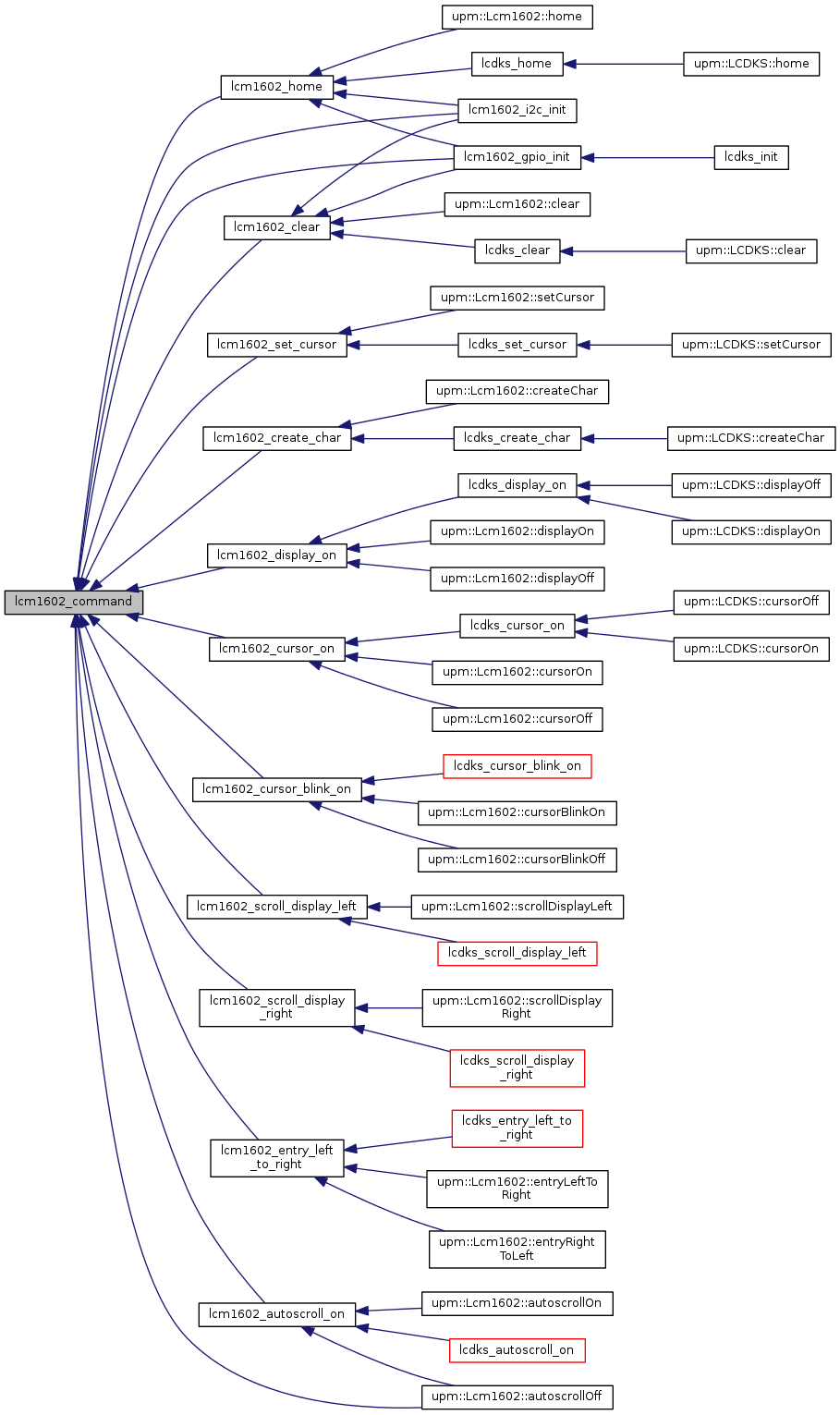

 1.8.11
1.8.11